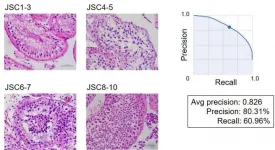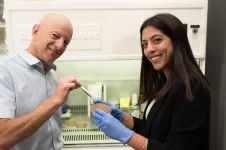INFORMATION:
Smashing the Covid curve
Scientists at IST Austria show that little differences in behavior decide between success and complete failure of epidemic control.
2021-05-10
(Press-News.org) What has fluid physics to do with the spreading of the Corona virus? Whirlpools and pandemics seem to be rather different things, certainly in terms of comfort. Yet, newest findings about epidemic spreading come from Physics professor Björn Hof and his research group at the Institute of Science and Technology Austria (IST Austria), who specialize in fluids and turbulent flows. When early last year Björn Hof had to cancel his scheduled visit to Wuhan, his wife's hometown, his focus abruptly shifted to epidemic spreading.
"My group normally investigates turbulent flows in pipes and channels", he explains, "Over the last 10 years we have shown that the onset of turbulence is described by statistical models that are equally used to describe forest fires and epidemics." Given this experience, programming an epidemic model was a straightforward exercise for Burak Budanur, the group's theorist and computational expert.
The epidemic curve does not flatten, it collapses
Standard epidemic models suggest that the level of mitigation has a continuous effect on the height of the epidemic peak. "The expectation is that the curve flattens in proportion to the level of social distancing", says Davide Scarselli, main author of the paper. However, when he first simulated epidemics taking limits in testing and contact tracing into account, the picture was a very different one. The maximum of infected people initially decreased as expected but then suddenly collapsed to almost zero as the mitigation level reached a certain threshold. In one limit, approximately half of the people got infected during the epidemic. In the other one only three percent caught the disease. Surprisingly, it was impossible to obtain a result in between these two outcomes: Either there is an outbreak of considerable size, or there is almost none whatsoever.
Failure yields faster than exponential growth
Testing of known contacts (not testing per se) is one of the most powerful ways to slow down an epidemic. However, the number of cases that can be traced every day is limited and so is the number of tests that can be administered. As the researchers found out that exceeding these limits at one point during the epidemic has far-reaching consequences. "If this happens", says Timme, "the disease begins to spread faster in the unchecked areas and this unavoidably causes a super-exponential increase in infections." Already, exponential growth is immense. It means doubling infections every few days. Super-exponential though signifies that even the rate of doubling becomes faster and faster.
As long as this acceleration can be avoided, epidemic curves collapse to a comparably low case level. Interestingly, it matters relatively little whether contact tracing is protected by a small or a large safety margin. The numbers remain comparatively low. If on the other hand the limit is only surpassed by a single case the super-exponential growth causes the total case numbers to jump to a tenfold level.
Marginal differences and disproportionate effects
"Like most nations, Austria didn´t react early against the second wave. Once not all contacts could be traced anymore during last September, it wasn't difficult to predict that case numbers would soon surge at a faster than exponential rate", says Scarselli. While over the last year it has become apparent that an early and decisive response is essential when facing exponential growth, the team's study shows that test limits make timing even more crucial. The difference between success and failure of a lockdown is marginal, or as Budanur puts it: "A policy that would have worked yesterday will not only take much longer to take effect, but it may fail entirely if it is implemented a single day too late." Hof adds: "Most European countries only reacted when health capacity limits became threatened. Actually, policy makers should have paid attention to their contact tracing teams and locked down before this protective shield fell apart."
More recently the team has looked into optimal strategies, where lockdowns are used as a preventive tool rather than an emergency brake. A manuscript that outlines the optimal strategy, which minimizes both, the number of infected people and the required lockdown time, is currently in progress.
ELSE PRESS RELEASES FROM THIS DATE:
Male infertility scoring using AI-assisted image classification requiring no programming
2021-05-10
Infertility affects females and males equally. In male infertility, azoospermia (a medical condition with no sperm in semen) is a major problem that prevents a couple from having a child. For the treatment of patients with azoospermia, testicular sperm extraction (TESE) is required to obtain mature sperms. When examined, histological specimens are typically given a score, called the Johnsen score, on a scale of 1 to 10, based on the histopathological features of the testis.
"The Johnsen score has been widely used in urology since it was first reported 50 ...
Research results challenge a decades-old mechanism of how we hear sounds
2021-05-10
Researchers at Linköping University, Sweden, have made several discoveries on the functioning mechanisms of the inner hair cells of the ear, which convert sounds into nerve signals that are processed in the brain. The results, presented in the scientific journal Nature Communications, challenge the current picture of the anatomical organisation and workings of the hearing organ, which has prevailed for decades. A deeper understanding of how the hair cells are stimulated by sound is important for such matters as the optimisation of hearing aids and cochlear implants for people with hearing loss.
In ...
Parallel universes cross in Flatland
2021-05-10
In 1884, Edwin Abbott wrote the novel Flatland: A Romance in Many Dimensions as a satire of Victorian hierarchy. He imagined a world that existed only in two dimensions, where the beings are 2D geometric figures. The physics of such a world is somewhat akin to that of modern 2D materials, such as graphene and transition metal dichalcogenides, which include tungsten disulfide (WS2), tungsten diselenide (WSe2), molybdenum disulfide (MoS2) and molybdenum diselenide (MoSe2).
Modern 2D materials consist of single-atom layers, where electrons can move ...
Could wider use of gene reserves protect rare species?
2021-05-10
UK landowners and conservationists welcome wider-spread use of Gene Conservation Units (GCUs) to help protect some of the rarest plants and insects, research at the University of York has shown.
In particular the Great Yellow Bumblebee and the Mountain Ringlet Butterfly, which are at risk of further population decline, would benefit from Gene Conservation Units, currently only employed for forest trees and agricultural species or their relatives.
Genetic diversity in these species is essential if they are to adapt to new, and often challenging, environmental conditions. Gene Conservation Units are areas of land managed to allow the recovery of species, and maintain evolutionary processes to enable them to adapt to environmental change.
For tree species, ...
Worldwide network develops SARS-CoV-2 protocols for research laboratories
2021-05-10
FRANKFURT. When the SARS-CoV-2 virus mutates, this initially only means that there is a change in its genetic blueprint. The mutation may lead, for example, to an amino acid being exchanged at a particular site in a viral protein. In order to quickly assess the effect of this change, a three-dimensional image of the viral protein is extremely helpful. This is because it shows whether the switch in amino acid has consequences for the function of the protein - or for the interaction with a potential drug or antibody.
Researchers at Goethe University Frankfurt and TU Darmstadt began networking internationally from the very start of the pandemic. Their goal: to describe the three-dimensional structures ...
Sharks in protected area attract illegal fishers
2021-05-10
Thousands of sharks have been illegally caught in a Marine Protected Area (MPA) in the Indian Ocean, new research shows.
The MPA was created in 2010 around the Chagos Archipelago, also known as the British Indian Ocean Territory (BIOT), banning all fishing there.
The new study examined information on illegal fishing in the MPA - a vast (640,000 km²/250,000 mi2) area containing pristine and remote reefs.
Enforcement data suggests more than 14,000 sharks were caught in the MPA from 2010-20, but discussions with fishers in the region suggest the true number was "considerably ...
Molecular tweezers that attack antibiotic resistant bacteria developed by Ben-Gurion U.
2021-05-10
BEER-SHEVA, Israel May 10, 2021 - Researchers from Ben-Gurion University (BGU), together with American and German colleagues, have developed new "molecular tweezers" to combat antibiotic-resistant bacteria. Their recently announced findings were published in Cell Chemical Biology.
For years, medical professionals have struggled with bacterial infections becoming increasingly resistant to antibiotics. These molecular tweezers may be the key to battling one of greatest public health issues of the 21st century.
"Our discovery prevents infection without building up antibiotic resistance, and it might even be preferable to develop treatments based on molecular tweezers rather than antibiotics," said BGU Department of Chemistry Prof. Raz Jelinek.
The research team, led ...
Cricket bats should be made from bamboo not willow, Cambridge study finds
2021-05-10
Bamboo cricket bats are stronger, offer a better 'sweet spot' and deliver more energy to the ball than those made from traditional willow, tests conducted by the University of Cambridge show. Bamboo could, the study argues, help cricket to expand faster in poorer parts of the world and make the sport more environmentally friendly.
"The sound of leather on willow" may have delighted cricket lovers for generations but the sport should now consider making the blades of its bats with bamboo, say researchers from Cambridge's Centre for Natural Material Innovation. ...
Future-proofing mental health -- Experts set out research roadmap to prioritise key areas
2021-05-10
A group of UK academics are calling for targets for mental health in order to meet the healthcare challenges of the next decade.
Published today in Journal of Mental Health researchers set out four overarching goals that will speed up implementation of mental health research and give a clear direction for researchers and funders to focus their efforts when it comes to better understanding the treatment of mental health.
The treatment of mental illness currently brings substantial costs to not only the NHS, but also to the individual and wider society, and the need for innovation to promote good mental health has never ...
Body mass index during childhood linked with risk of anorexia nervosa and bulimia nervosa in later life
2021-05-10
New research being presented at the European Congress on Obesity (ECO) held online this year, suggests that among girls a low body mass index (BMI) during childhood indicates a higher risk of developing anorexia nervosa as young adults, whereas a high BMI or overweight in childhood indicates a higher risk of bulimia nervosa.
"By examining the records of thousands of girls over their lifetime in national health registers, we have discovered early warning profiles that could signal girls at risk for anorexia nervosa and bulimia nervosa", says lead author Dr Britt Wang Jensen ...
LAST 30 PRESS RELEASES:
There are new antivirals being tested for herpesviruses. Scientists now know how they work
CDI scientist, colleagues author review of global burden of fungus Candida auris
How does stroke influence speech comprehension?
B cells transiently unlock their plasticity, risking lymphoma development
Advanced AI dodel predicts spoken language outcomes in deaf children after cochlear implants
Multimodal imaging-based cerebral blood flow prediction model development in simulated microgravity
Accelerated streaming subgraph matching framework is faster, more robust, and scalable
Gestational diabetes rose every year in the US since 2016
OHSU researchers find breast cancer drug boosts leukemia treatment
Fear and medical misinformation regarding risk of progression or recurrence among patients with breast cancer
Glucagonlike peptide-1 receptor agonists and asthma risk in adolescents with obesity
Reviving dormant immunity: Millimeter waves reprogram the immunosuppressive microenvironment to potentiate immunotherapy without obvious side effects
Safety decision-making for autonomous vehicles integrating passenger physiological states by fNIRS
Fires could emit more air pollution than previously estimated
A new way to map how cells choose their fate
Numbers in our sights affect how we perceive space
SIMJ announces global collaborative book project in commemoration of its 75th anniversary
Air pollution exposure and birth weight
Obstructive sleep apnea risk and mental health conditions among older adults
How talking slows eye movements behind the wheel
The Ceramic Society of Japan’s Oxoate Ceramics Research Association launches new international book project
Heart-brain connection: international study reveals the role of the vagus nerve in keeping the heart young
Researchers identify Rb1 as a predictive biomarker for a new therapeutic strategy in some breast cancers
Survey reveals ethical gaps slowing AI adoption in pediatric surgery
Stimulant ADHD medications work differently than thought
AI overestimates how smart people are, according to HSE economists
HSE researchers create genome-wide map of quadruplexes
Scientists boost cell "powerhouses" to burn more calories
Automatic label checking: The missing step in making reliable medical AI
Low daily alcohol intake linked to 50% heightened mouth cancer risk in India
[Press-News.org] Smashing the Covid curveScientists at IST Austria show that little differences in behavior decide between success and complete failure of epidemic control.








